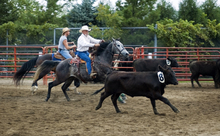Although research has failed to fully address the causes of inflammatory airway disease (IAD) in horses, a variety of agents are thought to be involved and their relative contribution to the development of IAD varies among different populations of horses based on feeding, housing, and preventive medicine practices, and differences in distribution of infectious agents and genetic influences.

Causes of horse breathing problems
Successful treatment of inflammatory airway disease (IAD) requires environmental management to minimize exposure to irritants and combination drug therapy to reduce pulmonary inflammation and prevent bronchoconstriction.
Research has shown that noninfectious agents are likely to be central to the development of IAD. Horses housed in stables are potentially exposed to high burdens of aerosolized particles and gases in a cumulative manner. Several studies have identified introduction of horses to a stable as a risk factor for IAD and high dust concentrations are common in the environment of conventional stables.
Within this dusty environment a variety of organic and inorganic particles including endotoxins, mite debris, vegetative material, inorganic dusts, and noxious gases.
Successful treatment of inflammatory airway disease (IAD) requires environmental management to minimize exposure to irritants and combination drug therapy to reduce pulmonary inflammation and prevent bronchoconstriction.
Aerosolized drug therapy has been shown to be an efficient means of treatment for most horses with IAD. Aerosolized drug therapy has been standard treatment for human patients with non-infectious respiratory disease for 20 yr. Inhalation therapy improves drug safety and efficacy by reducing the total therapeutic dose, minimizing drug exposure to other body systems, and allowing direct delivery of the drug to the lower respiratory tract.
In most instances, the response to aerosolized drug administration is more rapid than systemic drug administration. Equine patients are ideal candidates for inhalation therapy because of their cooperative nature, large tidal volume, and obligate nasal breathing. Early devices designed for delivery of aerosolized drugs to the lower respiratory tract of horses were cumbersome, expensive, and marginally efficacious.
The most important features of an aerosol administration system for horses are efficient pulmonary drug delivery and ease of administration. The disadvantages of the aerosol route of administration include access to obstructed airways, expense, frequency of drug administration, airway irritation by some aerosol preparations, and environmental impact of propellants.
Inflammation of the airway is not the same in every horse, says Alessandra Pellegrini-Masini, DVM, Ph.D, Dipl. ACVIM, of the University of Georgiaâs College of Veterinary Medicine. The first significant indication that should trigger a test for IAD is poor performance and slow recovery after exercise and chronic cough. Pellegrini-Masini says studies found that in some warmbloods, the only sign that something is wrong with the horse may be a reluctance to work with its head collected.
According to Pellegrini-Masini, clinical signs are worse in horses that live in a hot, humid environment. She says a low dose of Interferon-alpha effectively reduces inflammation, while a high dose is less effective. The interferon also reduces the intensity of the inflammatory response to pollutants and allergens.
Pellegrini-Masini says there has been no scientific evidence that IAD leads to recurrent airway obstruction or chronic obstructive pulmonary disease. âThe syndromes are different, but they can overlap,â she says.
Environmental IAD can be cured, Pellegrini-Masini says, if horse owners make permanent changes for their animal. She says veterinarians should recommend that owners:
- Reduce dust, allergens and other toxins in the barn and pasture.
- Avoid using hay or straw for bedding. Wood shavings, shredded paper or cardboard are alternatives.
- Replace hay with a pelleted diet. âThere are some good feeds on the market that provide the fiber the horse needs without dust,â she says. âFeed companies also have a formulation that combines hay and molasses specifically for horses with IAD and allergy problems.â
- Feed hay on the ground, in the natural position in which a horse grazes, not above his head in a hay net or rack. âHorses are designed to eat with their heads down. There is a natural flow to help mucus to clear,â she says.
- Allow horses to spend more time in a pasture. Some do much better when they are not in a stall or a barn.
IAD frequently goes unnoticed in backyard horses and broodmares. It is usually diagnosed in performance horsesâdressage, hunter-jumpers and racehorses. Research shows that horses that compete and work in arenas where saturation of the air with contaminants is high are more proned to IAD.
Benjamin Buchanan, DVM, Dipl. ACVIM, Dipl. ACVECC, of Brazos Valley Equine in Navasota, Texas treats many IAD-afflicted Quarter Horse racehorses, Western sport horses and barrel racers. âI see barrel horses that have run on Thursday, Friday, Saturday and Sunday,â he says. âTheyâve inhaled dirt from the arena and are having a hard time working and cooling off. It takes them a long time to catch their breath.
According to Buchanan breaking the cycle of inflammation and improving the environment are important in preventing IAD and improving the health of horses.
